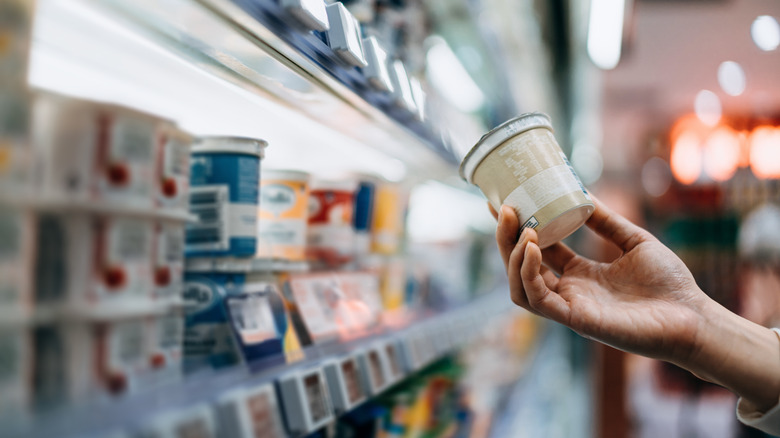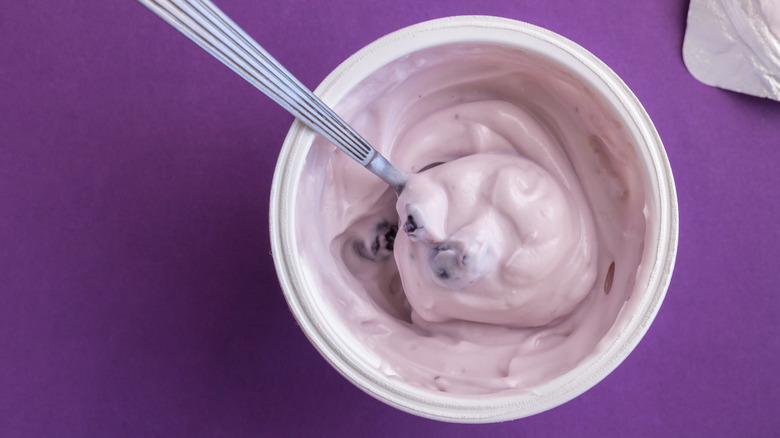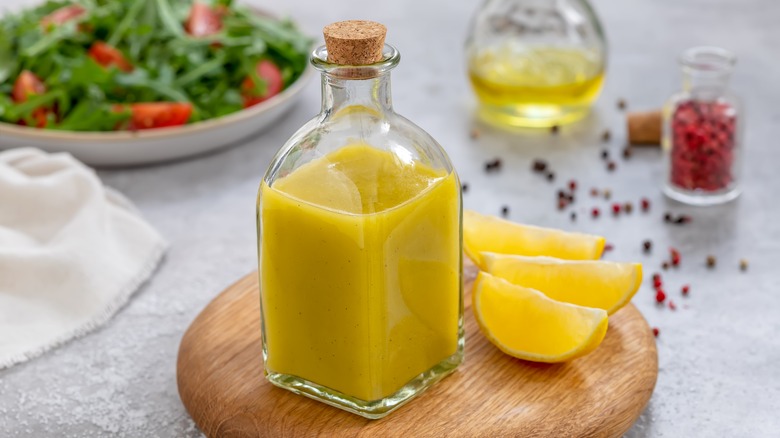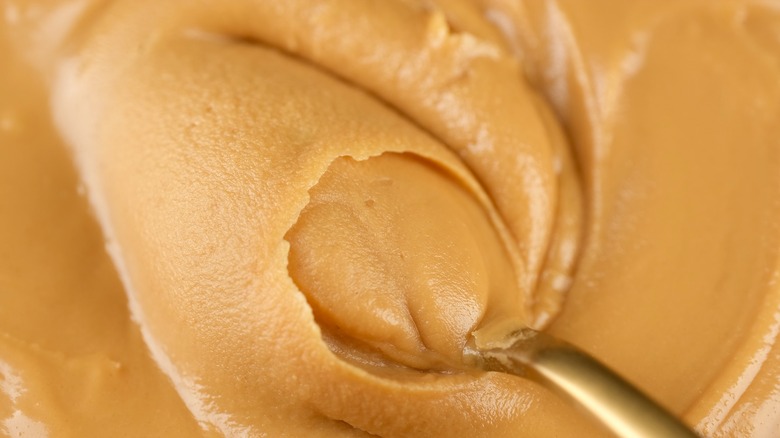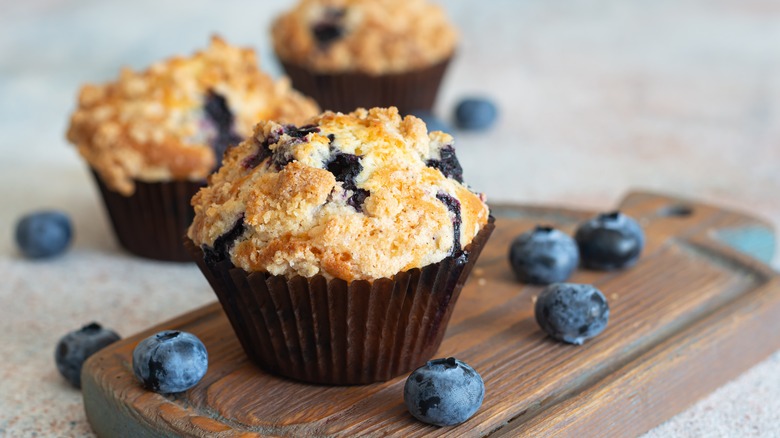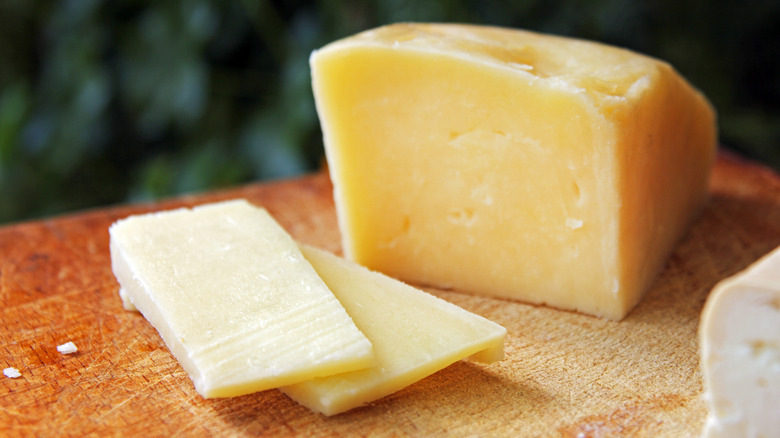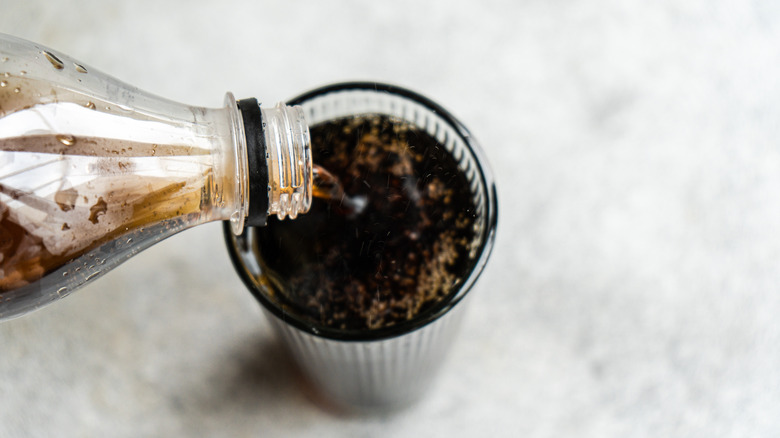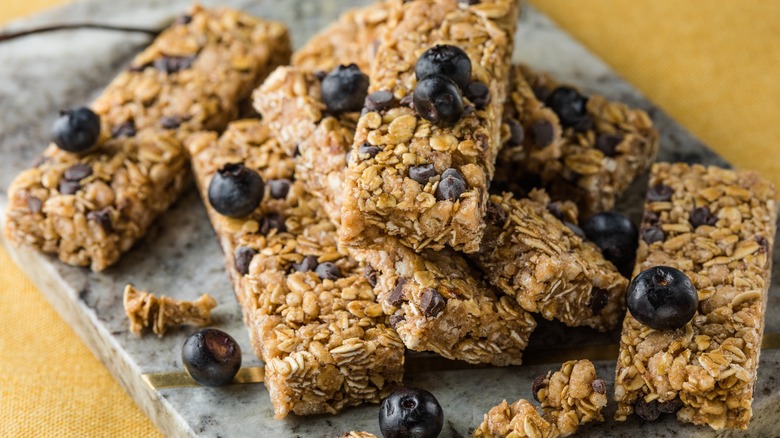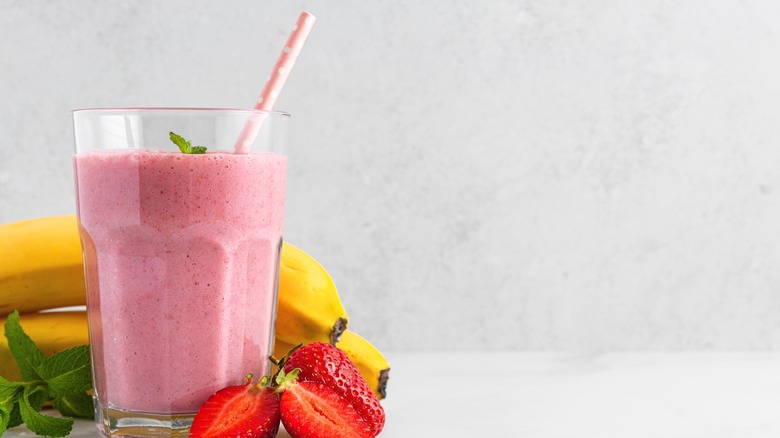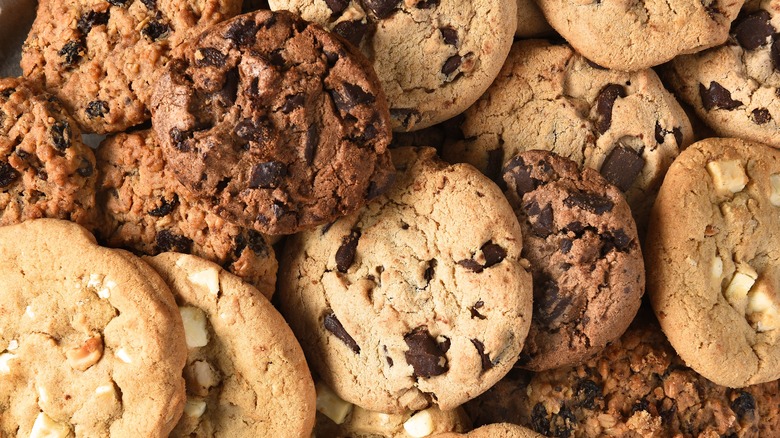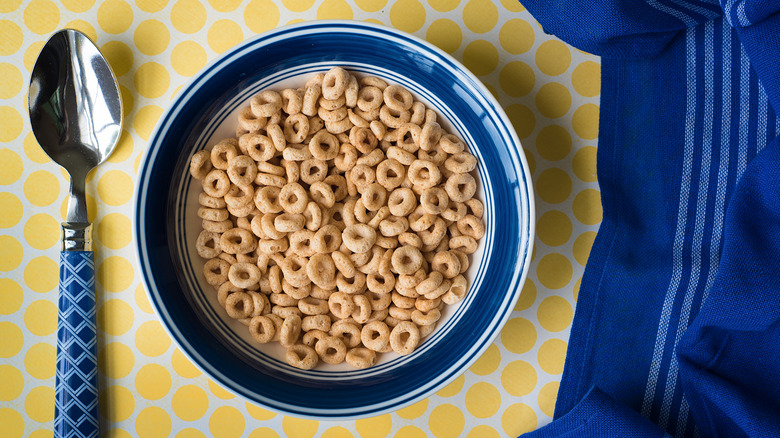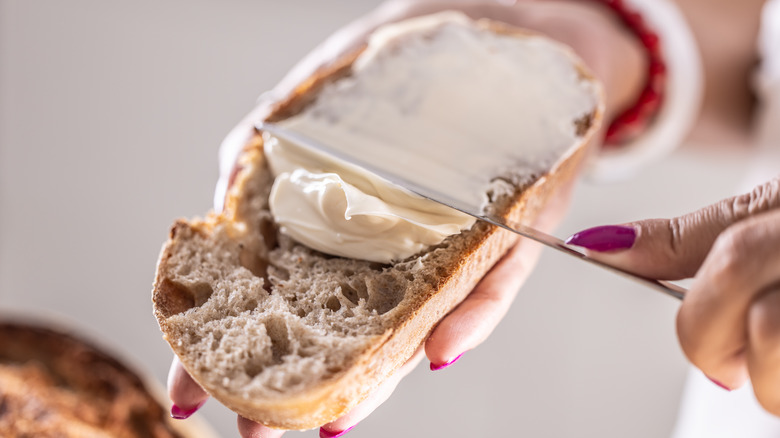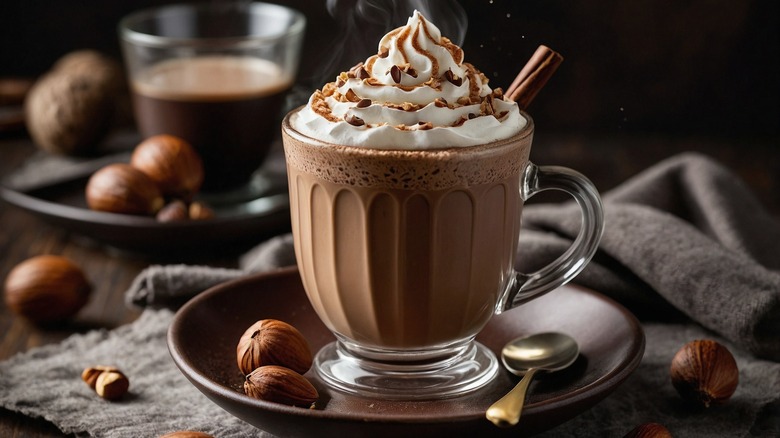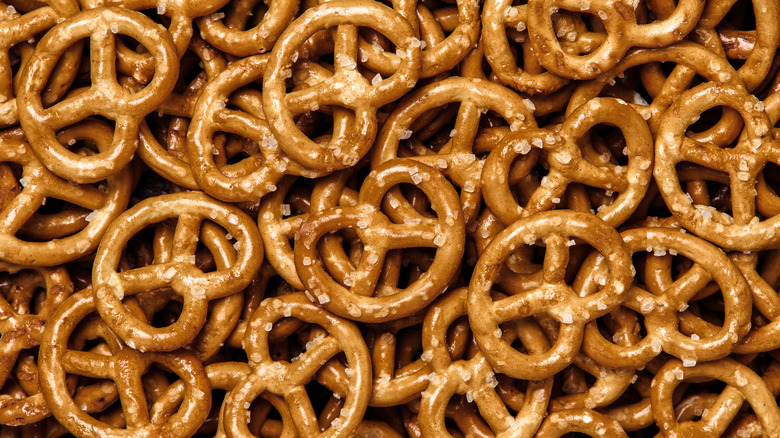14 Of The Unhealthiest Low-Fat Foods You Can Buy
Of all the food labels out there, "low-fat" is one of the most deceptive. On the surface, low-fat foods feel like a good thing to buy: We've been taught that fatty foods are unhealthy, and so if something's low-fat that can only be a good thing, right? Cue filling our baskets with low-fat yogurts, cheeses, and smoothies, safe in the knowledge that it'll be good for us. Except it might not be.
There's a false belief that "low-fat" also means "healthy" and that's simply not the case. While some low-fat foods can be healthy, others can be full of added sugar, copious amounts of salt, or a range of additives that bulk it out and make them more palatable — but may not be that good for you.
Ingredients like sugar and salt may lack fat, but they can also contribute to unhealthy outcomes in other ways. These nutrients are often added to improve the taste of low-fat products, which often lose flavor when fat is removed. In this article, we decided to look at the biggest culprits out there. We primarily identified foods that had additional or alternative ingredients that bolstered their flavor — and in doing so, made them unhealthier by raising their sugar or sodium levels, adding in unnecessary extra stabilizers or fillers, or using unhealthy ingredients that could have negative health effects.
1. Low-fat yogurt
There are a lot of unhealthy yogurt brands out there. While low-fat yogurt may seem like a good idea, it's often anything but. Low-fat and nonfat fruit yogurts can often be full of sugar, which makes them sweeter. A standard non-fat fruit yogurt may have no fat, but it can also contain approximately 12.5 grams of sugar, with some brands containing even more per serving. What's more, the majority of these sugars are added to the product.
It's these added sugars that are particularly problematic. While naturally occurring sugars are present in lots of foods, added sugars push things to extremes and give our bodies energy and calories that we likely don't need to function. Plus, added sugar intake has not just an effect on our blood sugar, but it also has a big impact on our potential to develop chronic diseases like high blood pressure and diabetes. It's worth remembering, too, that full-fat dairy products may not necessarily be bad for you when they're eaten in moderation. With both low-fat and full-fat yogurts, it's best to keep an eye on what's in them, and make sure you're not consuming too much of one nutrient that could knock your diet off-balance.
2. Low-fat salad dressing
It's not too hard to make salad dressing in a flash, but if you're in a pinch and you want a light lunch, low-fat bottled dressing is easy to reach for. Unfortunately, you'll probably end up eating some other things you really don't want. Light and nonfat salad dressings have significantly more sugar than regular salad dressings, and in some cases contain almost three times as much as full-fat versions. These sugars, as you might expect, are added sugars, and come from sources like high fructose corn syrup, a notorious sweetener that can contribute to poor health outcomes.
If these salad dressings aren't crammed with sugar, then they often achieve their flavor through high levels of salt. Walmart's Great Value Fat Free House Italian Salad Dressing & Marinade, for example, had 340 milligrams of sodium per serving, approximately 15% of your daily value. Be wary of fat-free and low-fat salad dressings that are marketed as "sugar-free," too. As well as generally having high sodium contents, they may also achieve their sweetness through sweeteners like sorbitol, which can have their own impact on our health. Sorbitol, for instance, can have a laxative effect when it's eaten in higher quantities.
3. Low-fat peanut butter
It's hard to imagine peanut butter as a low-fat product, but the food geniuses out there have done it — and low-fat and reduced-fat peanut butters are now everywhere. They may not be that good for you, though. For starters, low-fat and reduced-fat peanut butters really don't give you that much of a saving on fat in the first place. Some brands reduce their fat content by just a few grams, with 12 grams of fat in two tablespoons of a standard reduced-fat peanut butter, compared to 16 grams in two tablespoons of a normal one.
Unfortunately, to compensate for the lost fat, food producers bulk up their peanut butters with additional ingredients, like sweeteners and starches. This can raise these peanut butters' carbohydrate content and sugar levels, making a food that's normally keto-friendly suddenly a little harder to incorporate into low-carb diets. They can also add in excessive amounts of sodium to improve their products' taste. On top of all this, it's worth remembering that the fats in peanut butter are often not that bad for you in the first place. Peanuts are full of healthy monounsaturated fats, which can have a beneficial effect on cholesterol. Importantly though, many peanut butter brands add in extra fat that may not be that healthy, so ensure that you're checking what's in your tub, or try making your own peanut butter.
4. Low-fat muffins
On the surface of things, low-fat muffins seem like they're a dream: All the sweetness of a muffin, while still keeping the fat content low? Sign us up. The issue with low-fat muffins, though, is what else goes into them. Like many other low-fat foods, low-fat muffins compensate for their lack of fat with extra ingredients, particularly with more added sugar. Not only does this raise the overall sugar and carbohydrate content, but it can also eliminate any drop in calories that taking the fat away provides. Plus, these muffins balance out all that extra sweetness with more sodium, with some low-fat muffins containing 700 milligrams per serving.
Additionally, both low-fat and regular-fat muffins are made with white flour. Taking the fat away doesn't make this key ingredient any healthier. White flour is virtually nutrition-free and has no fiber or protein to speak of. As a result, it can significantly impact your blood sugar, causing it to spike. These spikes are made even more drastic by the increased sugar content in low-fat muffins, making a food that seems healthier into sort of a disaster.
5. Low-fat cheese
Like many fatty foods, folks have found a way to make cheese look slightly healthier — but it's not all it's cracked up to be. Low-fat and reduced-fat cheese may have less fat, and which could be a good switch for folks following a lower-fat diet. Unfortunately, these cheeses are still fairly salty, with cheddar cheese brands averaging out at about 615 milligrams per 100 grams of cheese.
In our opinion, though, the bigger problem with buying low-fat or reduced-fat cheese is that it just doesn't benefit you that much. The biggest concern for most people when it comes to cheese is saturated fat, which is known to raise cholesterol. However, according to a 2016 study published in The American Journal of Clinical Nutrition, eating regular-fat and reduced-fat cheese seemed to have the same effect. The study compared two groups, one eating regular cheese and one eating a reduced-fat version, both for 12 weeks. At the end of the study period, the difference in each group's LDL cholesterol was the same — but crucially, the HDL (or "good") cholesterol of the group eating regular cheese had gotten slightly higher, marking a slight overall benefit. All the more reason to eat more regular cheese, right?
6. Low-fat sodas
Okay, so we should start with a little acknowledgment here: We know that all sodas are technically low-fat. We also know that "low-fat" is a pretty common term used to refer to sugar-free sodas, with "full-fat" sodas referring to regular-sugar ones. The point, though, is that whether you're calling them low-fat, sugar-free, or diet, these sodas are far from the healthiest options out there. While it's true that their lack of sugar means they only have a few calories per serving, the fact that they're flavored with artificial sweeteners may have some unintended consequences for your health.
One particular sweetener, aspartame, has been found to be especially problematic. Drinking aspartame may cause rises in your cortisol levels, which may then affect your digestive system. It's believed that over time, this could lead to insulin resistance and a higher chance of developing diabetes. Long-term consumption of aspartame may have an impact on your organs, specifically your liver, with research indicating that it could contribute to toxic liver disease. The issue, unfortunately, is that aspartame is in a lot of diet drinks, including Diet Coke and Sprite Zero. While it's still considered safe to drink, it may be wise to look for diet beverages that don't contain this tricky sweetener.
7. Low-fat cereal bars
Low-fat cereal bars sort of feel too good to be true: These mid-morning snacks promise health and wholesomeness, without any of the fat that could push them in the other direction. However, they're often way sweeter than you'd like. These cereal bars can contain high levels of sugar that counteract their relatively low-fat qualities, with snacks like Kellogg's Nutri-Grain bars having a dozen grams of added sugar per serving.
Low-fat cereal bars can also often be lacking in crucial nutrients that could make them a healthier and more appealing prospect. Nutri-Grain bars, and other copycat cereal bars from places like Aldi, have just a few grams of protein per serving, and just a single gram of fiber. These combined mean that you'll be getting a lot of sugar without any other nutrients working to regulate its effect on your blood sugar levels. As a result, eating low-fat cereal bars will leave your energy crashing and you hungry again shortly after you eat them, and you may end up consuming more throughout the day. On the other hand, cereal bars that contain fats from sources like nuts may also contain higher levels of fiber and protein, making them a more satisfying choice.
8. Low-fat smoothies
Smoothies are one of those things that should be healthy, but are often anything but — and low-fat smoothies can be especially troublesome. The problem with low-fat smoothies is that they're often astonishingly high in sugar, and while that sugar comes from fruit, it no longer has the buffer of the produce's cell walls. As a result, these sugars end up as "free sugars," which then spike your blood sugar and cause your energy levels to go on a rollercoaster ride.
It's also worth remembering that adding healthy fats to your smoothies and balancing out their sugar contents with other ingredients can make them way more nutritious. Adding some avocado to a smoothie can give you a load of monounsaturated fats and fill it with loads of extra fiber. Putting in some nuts can do the same thing, and gives your smoothies a boost of protein. Importantly, you need all of these nutrients to create a healthy, balanced diet, and while the idea of a low-fat smoothie might be appealing, it likely won't be as satisfying as one containing fat.
9. Low-fat cookies
If you're gonna treat yourself to a cookie, it might be tempting to take the edge off by going for a low-fat one. Don't be fooled that doing this will make them healthier, though. Low-fat cookies have to get their flavor from somewhere, and they'll likely still be full of sugar — which gives them their sweetness and contributes considerably to your added sugar intake.
Like other low-fat baked goods, low-fat cookies also have one big issue: They're made from refined white flour. This flour is stripped of a lot of its nutrients during its production, leaving it devoid of fiber, vitamins, and minerals. It should be pointed out that refined white flour is used in both full-fat and low-fat cookies, but either way, it's not great for you. Instead of looking for cookies that are lower in fat, we instead suggest looking for cookies that are higher in other nutrients. Opting for cookies that are made with more nutritious flours, like buckwheat or whole wheat flour, may provide you with more protein, fiber, and crucial minerals like iron and magnesium.
10. Low-fat breakfast cereals
Trying to find a healthy breakfast cereal can feel like trying to find a needle in a haystack. If you're finding it tricky, though, don't be fooled into thinking that low-fat choices are the way to go. While breakfast cereals like Frosted Cheerios may have just 1.5 grams of saturated fat and no saturated fat whatsoever, cast your eyes further down the nutritional information, and check out the 12 grams of added sugars per bowl. These cereals can also be surprisingly high in sodium, with Frosted Cheerios having 200 milligrams in each serving, almost 10% of your daily value.
Elsewhere, breakfast cereals can be low in fat, but also low in nutrients like fiber. As fiber can help sustain a low appetite and keep you going between meals, opting for cereals that don't include it, just because they're low-fat, can be a move that'll cost you. Plus, fats play an important role in absorbing certain vitamins, like vitamins A, D, and E – which can often be put into cereal during the fortification process. If you don't have any fats to go with your cereal, those vitamins may end up less bioavailable.
11. Low-fat sandwich spreads
Low-fat sandwich spreads can feel too good to be true: All the buttery goodness of a regular margarine or butter, but without all the fat. Unfortunately, these sandwich spreads are often highly processed, and whether they're low-fat or not, they're generally not that good for you. Margarines and other sandwich spreads tend to be made up of a range of oils, added colors and flavors, stabilizers, and extra additives — none of which exactly scream health. Although it's true that low-fat sandwich spreads may have less oil than the full-fat versions, they may also achieve a better texture through additional ingredients, like fillers or protein isolates.
It's also worth bearing in mind that choosing margarine over butter, whether low-fat or not, may not be the healthiest choice overall. Margarine can contain higher levels of omega-6 fatty acids, and when you eat too much of these it can be a problem. While they're important to consume in balance with omega-3 fatty acids, having too many omega-6 fats can lead to poorer health outcomes, like higher levels of inflammation.
12. Low-fat coffee drinks
The nutrients we get from our drinks can be just as impactful as the food we eat — and that goes for our coffee, too. Some coffees can be super-high in fat, with a standard Grande Caffè Mocha from Starbucks made with whole milk delivering 15 grams of fat and 10 grams of saturated fat. Given that's half of your daily value for saturated fat, it makes sense to want to opt for a low-fat version, right?
Well, yes — except that the low-fat version is still bursting with sugar. The 2% milk version of the Grande Caffè Mocha has 34 grams of sugar, and while it does have a little bit of fiber in there to help balance that sugar out, there are only 4 grams of the stuff. As a result, you're essentially getting a cup full of sugar, which will do nothing but spike your blood sugar levels and make you feel jittery — as if all that caffeine doesn't do that already. That's just the start of it, too — some pumpkin spice lattes out there are even more unhealthy, containing upwards of 70 grams of sugar per serving.
Having said this, there are some low-fat coffee drinks out there that aren't too bad for you. Opting for unsweetened coffee drinks made with skimmed or nonfat milk can be a healthy choice. Just try to hold off on the syrup.
13. Low-fat ice cream
Low-fat ice cream kinda seems too good to be true. To be honest, it kinda is. The problem with low-fat ice cream is that — you guessed it! — it can often still be high in sugar. These ice creams, which maintain their stability and creaminess without their normal fat content with various gums and ingredients like whey, can provide almost half of your daily value for sugar in one serving.
So what about those ice creams that promise that they're low in fat and sugar? What's the catch? Well, these ice creams are often flavored with artificial sweeteners which can pose health concerns in other ways. Erythritol is a common ingredient in these kinds of frozen desserts, and some research has found that it can be particularly dangerous for your heart health and may increase the risk of heart attack and stroke. Additionally, consuming large amounts of erythritol may impact your digestive system and cause intestinal upset, leading to everything from gas to diarrhea.
14. Low-fat pretzels
While low-fat pretzels may feel like a healthy alternative to chips, they're anything but. Sure, pretzels are generally pretty low in fat, but that salty flavor? It comes from salt, folks — a lot of it. One 28-gram serving of this snack, which comes to about 18 individual pretzels, will provide you with 450 milligrams of sodium. That's 20% of your daily value, the same amount as a full microwave meal from some more health-conscious food producers.
As well as this, pretzels are pretty much null and void when it comes to other nutritional factors. They have barely any fiber, just a few grams of protein, and a minimal amount of vitamins and minerals. Granted, higher-fat snacks aren't much better when it comes to fiber, protein, or other nutrients. However, full-fat potato chips can be significantly lower in sodium, with a standard serving of wavy potato chips containing just 135 milligrams. What you lose in some nutrients, you may gain in others, so always choose your nutritional choices wisely.
